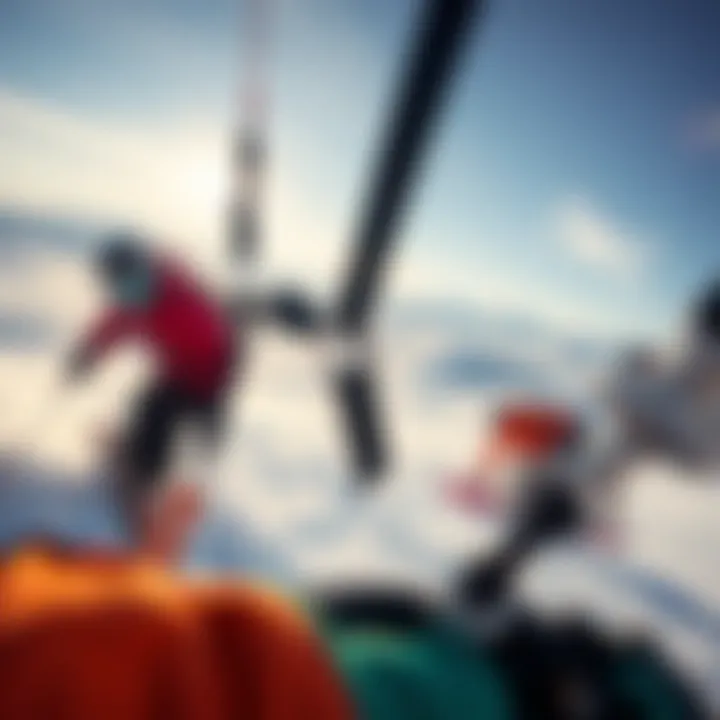Essential Insights into Snow Kite Harnesses for All Levels


Intro
Snow kiting is an exhilarating sport that blends the thrill of kiteboarding with the pristine beauty of snow-covered landscapes. A crucial component of this experience is the snow kite harness. A well-designed harness not only enhances comfort during long sessions on the slopes but also plays a vital role in ensuring safety and performance. Understanding the intricacies of different harness types, their design features, and how they meet the needs of both novices and seasoned riders helps you choose the right equipment.
This guide focuses on unraveling the layers of snow kite harnesses, exploring everything from the technical specifications to the maintenance routines that keep your gear in tip-top shape. It's not just about having the right gear; it's about knowing how to maximize its potential. We'll delve deep into the significance of harness selection and its direct impact on your snow kiting adventure, ensuring that you remain informed and prepared for the slopes.
Gear and Equipment
Equipping yourself with the right gear is the keystone of enjoying snow kiting. Whether you're a novice looking to dip your toes in the snow or an advanced rider seeking to sharpen your skills, understanding the essential equipment is vital.
Essential Kiteboarding Gear for Beginners
For those new to the sport, diving headfirst into the equipment choices can be overwhelming. Start with these key items:
- Snow Kite: Choosing a kite suited to your skill level and the wind conditions is crucial.
- Harness: A comfortable, well-fitting harness provides the support necessary for control.
- Board: Select a board that aligns with your riding style and skill level. Wide boards offer stability for beginners.
- Safety Gear: Don’t overlook helmets and impact vests.
Your initial investment in quality gear is fundamental, as it can greatly influence your learning curve.
Advanced Equipment for Experienced Riders
For those who have honed their skills over time, investing in advanced equipment becomes essential. The following are features to look out for:
- High-Performance Kites: Kites with quicker response to weather changes and enhanced durability can make a significant difference.
- Specialized Boards: From freestyle to directional boards, these cater to various riding styles, each offering unique performance benefits.
- Quality Harnesses: Advanced riders might opt for lighter options that still provide great support during high-speed maneuvers.
The right level of equipment not only enhances performance but can also lead to more enjoyable durations on the mountain.
Techniques and Tips
With the right gear in place, mastering the techniques of snow kiting can elevate the experience from ordinary to exhilarating. Here, we’ll touch on vital safety practices and useful training techniques.
Safety Practices for Kiteboarding
Safety should always be at the forefront when engaging in snow kiting. Here are some key practices to integrate into your routine:
- Check Weather Conditions: Always conduct thorough research on wind and weather patterns before heading out.
- Safety Checks: Regularly inspect your kite and harness for wear and tear.
- Kite Control: Practice controlling the kite in various conditions before taking on challenging environments.
- Communication: Always kite with a buddy and establish clear signals.
Training Techniques to Improve Your Skills
Progression in snow kiting takes practice and, at times, a bit of grit. Here are some techniques that can bolster proficiency:
- Practice on Flat Terrain: Develop basic control and turning in safe, unchallenging areas.
- Take Lessons: Professional instructors can offer tailored advice and techniques specifically suited to your skill level.
- Seek Online Communities: Engage with fellow enthusiasts on platforms like Reddit for tips and support.
By honing your skills and understanding the key aspects of snow kiting, you enhance your ability to enjoy the sport to the fullest.
"Investment in knowledge pays the best interest."
— Benjamin Franklin
For a deeper dive into safety guidelines, resources such as Wikipedia provide a wealth of information that can be beneficial for both novices and experienced kiteboarders.
Prolusion to Snow Kite Harnesses
Snow kite harnesses play a crucial role in ensuring a safe and enjoyable experience for enthusiasts of this exhilarating sport. They are not just accessories but vital tools that contribute to overall performance, enabling riders to maximize their control over the kite in varied snow conditions. At first glance, you might think the harness is simply about comfort or aesthetic appeal; however, the right harness can deeply affect a rider's effectiveness and endurance.
Understanding how harnesses work and what makes them suitable for different environments is essential for anyone venturing into snow kiting. From the materials they are made from to their specific designs, every detail is worth noting. The chance to engage in a thrilling partnership with the wind and snow relies heavily on this equipment.
Defining Snow Kite Harnesses
Snow kite harnesses are specialized equipment designed to secure the rider to the kite's lines. Their primary job is to distribute the pull of the kite evenly across the body. In essence, they are a bridge between the kite and the rider.
While they come in various styles and shapes, each harness serves a similar function: to stabilize the rider while they maneuver their kites. The most common types of snow kite harnesses include waist harnesses, seat harnesses, and hybrid models. Each type addresses different needs and preferences, making it imperative for a rider to choose wisely based on their personal comfort and style.
The Role of the Harness in Snow Kiting
In the world of snow kiting, the harness functions as the core point of connectivity, holding everything together. Without it, the experience would be akin to trying to drive a car without a seatbelt—certainly possible but perilous. The harness helps riders manage the immense forces at play, especially during strong winds or sudden gusts.
- Control and Stability: A well-fitted harness enhances control over the kite, allowing for precise movements and better stability.
- Safety Mechanism: Many modern harnesses incorporate safety features, providing peace of mind while riding.
- Fatigue Reduction: Good support from the harness can reduce fatigue, enabling longer sessions on the snow.
"The harness is more than a piece of gear; it's your lifeline during those exhilarating runs across the powder. Choose wisely and maintain it well."
Choosing the right harness is not just a matter of style; it's about ensuring that one can handle the rigors of snow kiting without compromising safety or comfort.
Types of Snow Kite Harnesses
When it comes to snow kiting, the choice of harness is crucial. Not only does it influence comfort during your ride but also dictates your overall performance. Each type of harness comes with its own set of features, advantages, and considerations, making it essential to comprehend the options available. By understanding the variances between waist, seat, and hybrid harnesses, you can make a choice that best suits your style and skill level.
Waist Harnesses
Design Characteristics
Waist harnesses are all about a snug fit around the torso. They typically sit at about the hips, ensuring that the kite's power is efficiently directed towards the rider. This design allows for a greater range of motion, particularly beneficial for tricks and maneuvers. The bottom line here is that the flexibility provided by the waist harness enhances your ability to handle the kite with precision. A noteworthy characteristic of this design is the low profile, which keeps the weight down, thus improving aerodynamics. However, it can sometimes lead to pressure points, especially on longer rides.
Pros and Cons


The popularity of waist harnesses is rooted in their balance of comfort and performance. Riders appreciate how well they can feel the kite without feeling too restricted. However, this comfort comes with a potential downside. For some riders, excess chafing may occur if the harness is not fitted correctly. On a blend of comfort and performance, waist harnesses generally hold their own well but might not suit everyone, especially those who carry weight differently.
Seat Harnesses
Features and Benefits
Seat harnesses are often favored by beginners and those who prioritize comfort over anything else. They are designed to fit snugly around the waist and lower back while extending down the thighs for additional support. The major selling point is stability—providing a secure anchor which allows the rider to engage with the kite without feeling unbalanced. For many people transitioning into snow kiting, this added support acts as a confidence booster.
Comparative Analysis
When stacking them against waist harnesses, seat harnesses stand out mainly for their user-friendly design. They are less likely to ride up during a crash or wipeout, offering an excellent safety net to novice riders. Nevertheless, the trade-off is that they can restrict leg movement, which might hinder performance for more experienced kiters who like to go airborne. Overall, seat harnesses serve an important niche but do require the right fit to really shine.
Hybrid Harnesses
Intermediate Solutions
Hybrid harnesses gracefully embody the best attributes of both waist and seat harnesses. They offer a balanced design which caters well to every rider type – from budding adventurers to pro-flyers. What sets hybrid harnesses apart is the ergonomic contour, which provides the torso support of a seat harness along with the freedom of a waist harness. This adaptability makes them an attractive choice for riders that enjoy a bit of everything.
Best Use Cases
Adventurers who tackle varying terrains and conditions often find hybrid harnesses to be their savior. They provide a fair mix of support and flexibility. If you're someone who mixes freestyle with cross-country snow kiting, these harnesses are definitely worth considering. On the flip side, though, if you’re primarily sticking to one style, the complexity may feel unnecessary. As it stands, hybrid harnesses are quite versatile, but they may not always align perfectly with a one-dimensional approach to kiting.
In summation, the type of harness you choose will directly affect your experience in the snow. Each has its merits and is tailored to fit specific needs. Exploring the nuances of these options can greatly enhance your overall kiting experience, ensuring that every outing is both enjoyable and productive.
Key Features of Snow Kite Harnesses
Understanding the key features of snow kite harnesses is essential for anyone looking to maximize their performance on the snow. A harness is more than just a supportive accessory; it plays a pivotal role in your overall experience while snow kiting. When equipped with the right features, it can enhance comfort, improve stability, and even add a level of safety during your thrill-seeking adventures. Whether you're soaring through the crisp winter air or gliding over powdery snow, the right harness can make a world of difference.
Material Composition
Durability Considerations
Durability is like the backbone of your harness; without it, you might as well be using a wetsuit in the Arctic. A harness needs to withstand the varied weather conditions and the rough handling typical in snow kiting. Generally, harnesses are crafted from materials such as ripstop nylon or high-denier polyester. These materials are known for their exceptional tear resistance and robustness.
One of the key characteristics of durable materials is their ability to resist abrasions. This is particularly important when you find yourself tumbling in the snow or taking a direct hit from an ice cold gust. The stronger the material, the more it can endure the wear and tear that comes with the sport. For example, ripstop nylon not only offers durability but is also lightweight, keeping your overall gear manageable.
A unique feature of durable harnesses is their longevity. Not only will they last through numerous seasons, but they'll also retain their support and shape. However, a word to the wise: even the toughest materials need proper care to live a long, healthy life.
Weight Factors
When it comes to snow kite harnesses, weight factors are everything. A heavy harness can turn your exhilarating ride into a strenuous workout. Ideally, the materials used should be lightweight yet strong enough to hold you securely. Most modern harnesses prioritize a balance between these aspects,
The lightweight characteristic of specific materials like Dyneema turns heads in the kiting community. Known for being incredibly strong yet light, it allows the harness to feel almost like a second skin. This contributes greatly to user comfort and can even enhance performance.
A significant downside could be the cost, though. Lightweight materials often come with a premium price tag. Moreover, very lightweight harnesses may compromise some durability; hence, a user must strike a balance between total weight and overall performance.
Adjustability and Fit
Strap Mechanisms
Strap mechanisms are the jewels in the crown of your harness' fit. These adjustments can make or break your experience on the snow. Properly fitting harnesses help to distribute weight evenly and minimize pressure points, making your rides more enjoyable.
The key trademark of effective strap mechanisms is their ease of use. Buckles that can be tightened or loosened quickly will save invaluable time—particularly useful during weather changes. Most harnesses utilize a mixture of Velcro and buckle systems, allowing for varied levels of customization.
However, sometimes these mechanisms can be less friendly when it comes to cold weather. Ice can cause Velcro to become brittle or ineffective, so in harsh conditions, keep an eye on how your straps behave.
Customization Options
Customization options take personal usage to a whole new level. Tailored adjustments can enhance both function and comfort, ensuring that your harness fits like a glove (or, more aptly, like a finely-tuned piece of equipment).
One significant aspect is your ability to modify different components of the harness. Many harnesses now offer detachable parts that allow you to fine-tune the fit for optimal comfort. Wearing it snugly but not excessively tight can greatly impact your mobility and responsiveness while snow kiting.
However, customization options can sometimes add complexity. Too many adjustments may make it difficult to find that right balance. That said, for the dedicated kiter, the benefits of a perfectly fitted harness far outweigh this downside.
Safety Features
Impact Resistance
When taking to the great white outdoors, the importance of impact resistance can't be overstated. Your harness must absorb and mitigate impact to protect your body in case of spills and tumbles. A well-designed harness can save you from serious injuries by dissipating the force of sudden stops.
The standout feature here is padding. Most contemporary harnesses come with padded sections that absorb shocks. Look for those with multi-layered foam, as these often offer better protection while staying lightweight.
Yet, it’s important to note that too much padding might restrict movement. Finding that balance is crucial, especially if speed and agility are your top priorities.
Quick Release Systems
When you’re snow kiting, sometimes conditions can change in a heartbeat. This is where quick release systems shine. Designed for efficiency, these mechanisms allow you to detach yourself from the harness almost instantaneously in case of emergency.
The practical element of these systems lies in their simplicity. A good quick-release mechanism should be intuitive, allowing you to operate it without having to think twice, even in a panic. Most of these systems involve a single touch of a button or pull of a cord.
However, some find that certain quick releases may be prone to accidental disengagement. Picking a harness with a reputable and well-reviewed design can help mitigate this issue.
Ultimately, understanding the core features of snow kite harnesses gives you a clearer perspective on what to look for when selecting the right one for your own snow-kiting journey. These elements not only enhance your performance but also safeguard your experiences on the snow.


Selecting the Right Harness
Choosing the right snow kite harness isn't just a matter of personal preference; it has a direct impact on your performance, comfort, and safety out on the snow. The right harness can make a riding session enjoyable and can greatly enhance your control over the kite. Factors like your skill level, body type, and even how you want the harness to fit can all influence your selection process and the overall experience.
Assessing Skill Level
Beginner Considerations
For those just starting their journey in snow kiting, selecting the right harness is essential. Beginners often look for a harness that's forgiving and easy to adjust, which contributes to a positive learning environment. A key characteristic of beginner harnesses is their simplicity in design. Many of these harnesses come with adjustable straps that allow riders to find a comfortable fit with minimal fuss.
One popular option is the seat harness. Its design helps keep the rider low to the ground, providing excellent stability while getting accustomed to kite control. This feel of security can make a significant difference. That being said, these beginner harnesses might lack some advanced features found on more sophisticated models, hence the trade-off in performance could be felt as one progresses in skill.
Advanced Requirements
On the flip side, advanced riders have specific demands when it comes to their harness. The insulation and freedom of movement that advanced harnesses often offer can drastically enhance performance in high-pressure situations. A key characteristic here is support. Advanced harnesses usually provide additional back support and a snug fit to help maintain posture while handling powerful kites.
Moreover, riders who are more experienced may prefer waist harnesses for their superior mobility and freedom of movement during tricks or advanced maneuvers. These harnesses, however, come with the complexity of needing an established understanding of proper adjustment and fit. A poorly fitted advanced harness can lead to discomfort during long sessions, thus making it crucial for experienced riders to ensure a tailored fit and performance-oriented features.
Understanding Body Types
Customization for Comfort
Not all bodies are created equal, and this is where customization plays a pivotal role. Different body types influence how harnesses fit and feel, so this element is crucial in the selection process. A key characteristic of customizable harnesses is their multiple adjustment points that cater to varied body shapes and sizes. Riders can tweak the straps to achieve the desired snugness without sacrificing comfort.
For example, women or those with taller torsos might find a specific harness design better suits their physique. A well-fitted harness minimizes discomfort caused by pressure points. While customization can take time and effort to figure out initially, the long-term comfort and support during snow kiting makes it worthwhile.
Weight Distribution
Weight distribution is another consideration that can dramatically affect performance and comfort while engaging with kites. Properly harnessed weight is imperative for balance and control. A well-designed harness will redistribute the forces from the kite evenly across your body.
Harnesses with wide, padded belts are particularly beneficial as they can help alleviate pressure on sensitive areas such as the lower back and hips. Finding a balance can mean the difference between a joy-filled session and a frustrating experience with aches and pains. As every rider's body is different, evaluating how a harness fits your specific weight distribution is essential.
In summation, selecting the right harness requires consideration of skill level, body type, and personal preference. Each factor plays a vital role in ensuring comfort and performance on the snow. Once you've considered all elements, you're better positioned to find a harness that truly elevates your snow kiting experience.
Routine Maintenance of Harnesses
Routine maintenance of snow kite harnesses is crucial for maximizing both performance and longevity. Harnesses are subjected to extreme conditions, making them vulnerable to wear and damage. Proper care not only enhances the safety of the equipment, but also ensures a comfortable experience for the user. An overlooked harness can lead to performance issues or even accidents, which no rider wants.
Cleaning Techniques
Material-Specific Care
Every material has its own quirks when it comes to care, and knowing how to treat it right can make all the difference. For instance, harnesses made from nylon are popular due to their lightweight nature and resistance to rot. Washing them with mild soap and water helps maintain fabric integrity without causing wear. In contrast, harnesses that incorporate leather require a different approach. Here, conditioning oils play a vital role in maintaining flexibility and preventing cracking.
It's important to follow manufacturer instructions for each type, as improper care might void warranties. So, whether you’re dealing with a high-tech synthetic or classic leather, understanding the specific characteristics of the material can help extend its lifespan considerably.
Frequency of Maintenance
The maintenance frequency can be as critical as the methods used. Regular checks after every use can help catch issues before they become problematic. Ideally, after every session, conduct a visual inspection for frays or tears. A deep clean might be due every few outings, depending on how intensely you've ridden.
Routine maintenance may seem tedious, but it’s a worthy investment. Think of it like changing the oil in your car; a little effort goes a long way. However, over-maintaining can also be a pitfall. Too much cleaning can potentially strip protective treatments away, so moderation is key here.
Storage Guidelines
Optimal Storage Conditions
Understanding how to properly store your harness is just as important as cleaning it. Ideal storage conditions involve keeping the harness in a cool, dry place, away from direct sunlight. Excessive heat or sunlight can weaken materials over time, turning your reliable gear into a liability. A simple cotton bag can offer protection, keeping dust and grime at bay while allowing the material to breathe.
Airflow is a unique feature of proper storage; unlike a sealed container, open storage prevents mold and mildew. Many avoid this by just tossing their harness in a closet, but taking an extra step to store it smartly can save you from unnecessary replacement costs.
Avoiding Damage
Preventing damage while in storage should be a primary concern. This involves not only the conditions around your harness but also how it's treated in its resting phase. Never fold or crumple your harness tightly; instead, hang it or lay it flat. This avoids creating creases or stress points that can lead to premature wear and tear.
Storing harnesses alongside sharp objects or other gear can also lead to unseen harm. Proper organization is a must. Making sure your gear has its own dedicated space can help minimize the risk of damage. It might seem like a small detail, but optimal storage can be the difference between a harness lasting for years and needing a replacement sooner than expected.
"Taking care of your gear is like taking care of your body. A little upkeep goes a long way!"
By putting in a bit of work in these areas, kiteboarders can not only preserve their harnesses but also enhance their overall experience on the snow.
Common Challenges and Solutions
In the world of snow kiting, even the most seasoned enthusiasts can face their share of hurdles. Understanding common challenges like discomfort and performance issues can lead to better experiences on the snow. Tackling these issues proactively ensures that kiting remains enjoyable and safe. To navigate these, it's wise to adopt methods that can both alleviate problems and enhance your overall performance.
Discomfort and Chafing
Causes and Prevention
Discomfort during snow kiting often stems from various factors, but chafing is one of the most prevalent. This irritation can result from prolonged contact between the harness and skin, especially in cold conditions. A key characteristic of addressing discomfort is recognizing the materials used in harness designs. Check for harnesses lined with soft, breathable fabrics which minimize skin irritation. Having a quality layer directly against your skin can significantly reduce chafing.
Here are a few preventive actions to consider:
- Opt for a well-padded harness: Harnesses with good padding provide a buffer against harsh elements.
- Wear moisture-wicking base layers: These fabrics keep sweat away, reducing friction that leads to chafing.
- Regular adjustments: Ensuring a snug yet comfortable fit can minimize harness movement.


In this regard, a soft-lined harness is a popular choice since it balances comfort and function effectively. However, choosing the right size is just as crucial; an ill-fitting harness, no matter how well-padded, can lead to issues.
Adjustments and Fitting
Adjusting the fit of your harness plays a massive role in comfort and performance. Ensuring it's adjusted correctly allows for optimal pressure distribution across your body. A key aspect of this fitting is the strap mechanisms. Easy-to-use adjustments let you achieve that ideal balance between security and comfort on the snow.
Here's why adjustments matter:
- Enhanced stability: A well-fitted harness locks you into place, improving control over your kite.
- Reduced risk of injury: Proper fit alleviates pressure on key areas, minimizing the chance of bruising or soreness.
- Optimized performance: When you feel secure, your confidence soars, allowing for better execution of tricks and navigation.
To summarize, a harness's unique feature is its adjustability. When harnesses come with intuitive adjustment systems, it gives the rider the leverage needed to personalize fit on the go. However, over-tightening can restrict movement, so finding that sweet spot is essential.
Performance Issues
Identifying Problems
Instances of poor performance can be common, particularly in beginners. Knowing how to identify what’s hindering your kiting experience is invaluable. If the kite isn't responding as expected, it could be an indication of harness-related issues among other factors. A significant aspect to consider is how the harness interacts with your body mechanics during maneuvers.
Recognizing the signs:
- Lack of control: If the kite feels unresponsive, it might be a fitting issue affecting your connection to the kite.
- Unexpected movements: If you notice excessive shifting, the harness might not be snug enough.
- Continuous pain or soreness: Persistent discomfort points towards an adjustment or compatibility issue with your snow kiting setup.
By honing in on these signs, you can make informed decisions leading to improved performance.
Corrective Measures
When problems arise, knowing how to implement corrective measures can drastically improve your snow kiting experience. One effective route is through understanding how to make quick adjustments to your harness configuration. Getting snug with the drawstrings or resizing might be necessary during a session based on performance feedback.
A few common corrective strategies include:
- Frequent checks: Periodically check your harness during activities to ensure it remains secure.
- Revisiting settings: Changes in riding style may require you to revisit the initial settings on your harness.
- Seeking expert advice: Sometimes it pays to ask seasoned kiters for their insights on adjustments or techniques that may work better for you.
Future Trends in Snow Kite Harness Design
The world of snow kiting is evolving rapidly, and as with any sport, harnesses have followed suit. Understanding future trends in snow kite harness design not only prepares kiters for better experiences but also highlights the direction of innovation in the sport. With the rise of safety concerns, sustainability, and the push for personalized gear, the latest developments in harness technology reflect a commitment to performance and environmental responsibility.
Advancements in Materials
Eco-Friendly Options
As athletes and consumers alike become increasingly conscious of environmental impact, the advent of eco-friendly harness materials has gained momentum. Brands are now utilizing recycled fabrics and low-impact production techniques to create harnesses that do not compromise on performance or comfort.
These eco-friendly options are not just a passing trend; they signify a shift towards sustainability within the snow kiting community. The key characteristic of these materials is their durability paired with a reduced carbon footprint. A popular choice is harnesses made from recycled plastics or organic cotton blends.
One unique feature of eco-friendly materials is their contribution to maintaining the performance standards typical of traditional materials while enhancing comfort. For example, harnesses crafted from recycled nylon still boast resilience and resistance to wear and tear, ensuring that eco-conscious kiters don't sacrifice quality for sustainability. However, the potential downside may include slightly higher costs due to the advanced production processes involved.
Technological Innovations
The fast-paced nature of technological advancement is reshaping the design of snow kite harnesses. The introduction of lighter, stronger materials enhances efficiency without weighing down kiters. Notably, harnesses are increasingly incorporating features like wind-resistant fabrics and moisture-wicking designs that cater specifically to the dynamic and often harsh conditions of snow kiting.
A standout characteristic now seen in both amateur and professional harnesses is the integration of smart technology that measures performance metrics directly from the harness itself. This can range from tracking your movements to optimizing tension based on kiter weight and wind conditions. The inclusion of such technologies is a significant innovation for keeping snow kiters safer and better informed.
While these advancements provide excellent benefits, such as improved performance and safety, there can be drawbacks like potential tech malfunctions or increased maintenance requirements for high-tech features.
Customization and Fit Technologies
Smart Harnesses
The incorporation of smart technology extends beyond mere tracking. Smart harnesses are designed to be more responsive to the individual's body type, enhancing comfort and stability while kiting. These harnesses use sensors that can adjust tension and fit dynamically, providing optimal support regardless of movement variations or environmental changes.
Such a design allows for personalized fit, which minimizes discomfort during long sessions on the snow. Smart harnesses often engage with applications that not only provide performance analytics but also suggest adjustments to enhance your experience on the field. While these innovations offer immense benefits, it’s essential to be aware of the potential for reliance on technological solutions over traditional kiting skills.
Adaptive Gear
With the increasing focus on inclusivity in sports, adaptive gear tailored for different body types and needs is becoming more prominent in the snow kiting realm. Adaptive gear incorporates adjustable components that allow for a fit unique to the user. This could mean enhanced straps and padding that ensure snug fits for all body shapes, ultimately improving overall performance.
The key characteristic of adaptive gear is its flexibility in accommodating various kiting styles and abilities. Customization features make it a preferred option for those who may have previously faced challenges with standard harness designs. Unlike traditional harnesses, adaptive gear considers the diverse range of body types, which can enhance comfort and stability. However, while adaptive gear opens the door for more kiters, it can also lead to confusion in selecting the right fit if options are not clearly specified.
The future of snow kite harness design reflects an exciting convergence of technology, sustainability, and inclusivity, paving the way for enhanced experiences on the snow.
As we look to the horizon of snow kite harness design, the blending of advanced materials with intelligent customization signifies a belief in not just participating in the sport, but fully enjoying it, no matter who you are or how you ride.
Culmination
As we draw the curtains on our exploration of snow kite harnesses, it's vital to reflect on the significant role they play in the overall snow kiting experience. A well-chosen harness can be the difference between discomfort and seamless enjoyment. It serves not only as a physical connection to the kite but also as a facilitator of better performance and safety.
Recap of Key Insights
In navigating the complex world of snow kite harnesses, key insights emerged:
- Variety is Key: Different types such as waist, seat, and hybrid harnesses cater to various preferences and skill levels, ensuring that every kiter can find their perfect match.
- Material Matters: The choice of materials impacts both durability and weight, affecting how a harness performs over time in the harsh snowy conditions.
- Importance of Fit: Adjustability cannot be understated. A harness that fits well enhances control and minimizes the risk of injury, making customization crucial for all riders.
- Safety First: Modern harnesses come equipped with advanced safety features that provide peace of mind, allowing kite enthusiasts to focus on their ride rather than their gear.
"The right harness is not just an accessory; it can enhance your connection with the kite."
Final Thoughts on Harness Selection
When it comes to selecting the right harness, it boils down to personal preferences and the specific conditions of your snow kiting outings. Consider your skill level and body type; what works for one person might not suit another. Take the time to try on various options, assess the fit, and examine features that resonate with your riding style.
Ultimately, investing in a quality snow kite harness pays dividends in safety, performance, and enjoyment in this exhilarating sport. With careful consideration of design, material, and fit, you can elevate not just your experience but also your skills out on the snow. Equip yourself thoughtfully, and you may find that your snow kiting adventures become even more fulfilling.



